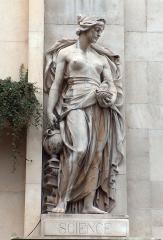 Allegorical statue of Science.
Allegorical statue of Science.
 Allegorical statue of Science.
Allegorical statue of Science.
We often find allegorical statues of different individual sciences such as Chemistry and Physics, or more broadly including Geography, Navigation and so forth, but sometimes we have a figure, or series of figures, emblematic of Science as a whole. The example above is a typical statue of Science. She is a semi-nude female figure in the Greek style, holding a flaming pot with a small chemical retort. Her other hand, hanging by her side, holds a compass, and rests on a mounted globe with a scroll on top. This sits on a precarious pile of thick books indicative of the accumulated scientific knowledge of the ages. She wears flowing drapes gathered above the waist, and flying behind her to form a setting for the figure. This figure, by Thomas Rudge, is in Bond Street, London.
Above left is a contrasting figure, again Greek in style, but this time a male figure, an elderly savant with head slightly bowed, resting his muscular arms on a high, enclosing chair. The only accoutrements are the two heavy volumnes beside him, partly hidden by his drapes. The figure below right returns to the female figure of Science, here indicated again by a globe, which she cradles on one hand, tracing around it with a finger from the other. Again we have a look of serious contemplation. This figure is dressed in a long skirt, covered with a cloak held in front of the neck by a brooch. Alfred Drury was the sculptor, and this is one of the eight enormous statues on the sides of Vauxhall Bridge in London.
Science sculpture above arches.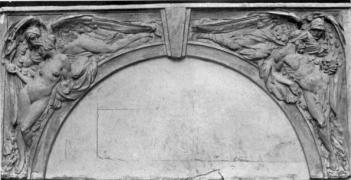
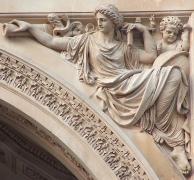
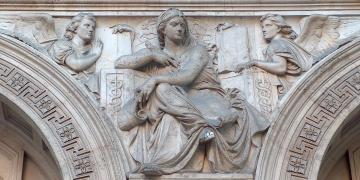
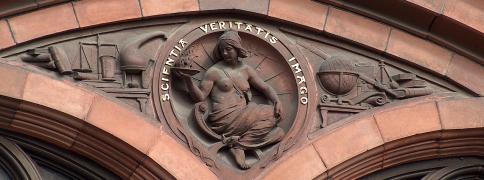
Here are a series of allegorical sculptures of Science above arches. First, Science and Art, forming the spandrels (curved triangles) above a central arch. S cience is the male figure, looking at a skull, while Art is the nude girl on the left; both are watched over by angels. The busy group next to it is on the front of the Foreign and Commonwealth Office in Whitehall. Science is female once more, a seated figure holding a scroll and quill pen, studying a book held by an angel on one side; a second angel on the other side holds a tablet or parchment. Once again we see the serious, contemplative expression characteristic of many statues of Science. There are nice details: the wide chair or throne on which Science sits have pairs of snakes wound round staffs, called Cadaceuses (see this page for more examples), the symbol of Mercury (Hermes), messenger of the Gods, appropriate for Science. Behind, we can see two of the signs of the Zodiac, thus indicative of Astronomy. Birnie Philip was the sculptor. Third along is a terra cotta figure, another semi-nude girl, holding a flaming lamp (lamp of knowledge), with a shooting star behind her indicating the birth of an idea. Around the rim of the circle in which the figure is crouched is the Latin phrase ‘Scientia Veritatis Imago’, which is a shortened form of ‘Scientia nihil aliud est quam veritatis imago’, or ‘Science is but an image of the Truth’, a quote from Francis Bacon. This roundel balances in a double spandrel where two arched windows meet, with a further arch above, giving spaces to left and right which are filled with scientific instruments moulded in relief. We see on the left the now-familiar retort on a tripod, a balance and measuring flask, and a heap of books. On the right is our globe, a telescope, books and a scroll, and a steam engine regulator or governor, indicative of Engineering sciences, together with more books and a scroll. The figure on the far right is an elegant Classical Greek girl beautifully posed in her spandrel, one foot turned towards us to show the under-side, not a common pose. One arm is stretched out to hold her telescope, the other turns upwards and forwards to hold a set-square indicative of Geometry; again a balance is there, just seen behind that hand. Also featured are a large globe, with pump cherub behind it, and a snake coiled about a stick, presumably a Staff of Asklepius emblematic of the Medical Sciences (again, see this page).
Here is a massive allegorical sculptural group, being the central part of Science and Education on the Crown Court in Cardiff. The figure to the right is likely Education, with her open book. She standing on the left is opening a Pandora’s box, so indicating the acquiring of Knowledge – she would do for Science or Education. But the larger seated central figure would seem to represent Science alone. She would be half again as tall as the figures in front were she to stand up, and unlike the Classical girls in front, is in Symbolist style, symmetrically posed with a penetrating stare beneath her cowl. She has in her two hands and across her lap a long scroll, which is unwinding down to the side and in front of her. Under one hand is a globe; under the other, a bowl on an ornate stand embellished with leaves, conceivably indicative of the Botanical sciences.
The Sciences: friezes of figure sculpture.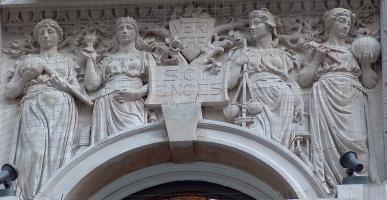
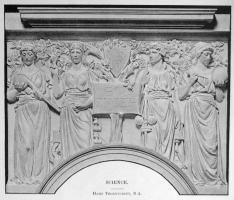
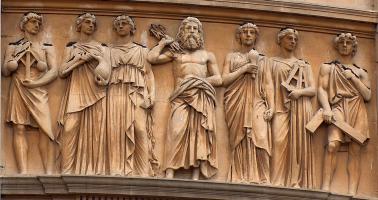
Above are two groups of allegorical figures representing the Sciences. To the left and centre are the group on the Institute of Chartered Accountants, by the sculptor Hamo Thornycroft. A good group, with four Greek girls to represent four different sciences: we have Chemistry on the left with her retort, and then Electricity, holding a light bulb, with electrical apparatus to her sides. In the centre, above the word ‘Sciences’, is a shield with ‘Veritas’ or Truth written upon it, mounted on a branching tree which would be the growing tree of Knowledge. On the right, is firstly Engineering Sciences; she holds a large steam engine regulator, as we have seen before, and has some pressure vessel and articulated arm behind her on the other side. Finally in the corner is Geography, with her globe and compasses. The second image below is an old picture which gives the face-on view of the rather angled photograph of this panel on the left. The third picture is a standing group of figures showing the Sciences, youthful Greeks both male and female, and an older one in the centre, the bearded figure of Zeus with a fistful of thunderbolts, representing Electricity. On the left as we look at the frieze is a male figure of Engineering with regulator, and then two girls side by side: Chemistry with her retort, and one holding a prism who would be Physics. On the right, another pair of girls has one holding a bulb, I think, thus Electricity again, and the other cradling a large sextant on her harm, thus Navigation. The final figure, a male, holds a large set square, which would be Geometry. George A. Lawson was the sculptor, and this is one of the friezes on the Guildhall, Bath.
Here is one more frieze, being a more conventionally Victorian group of figures representing the Sciences. First, an older man holding a ship, thus Shipping or Navigation. Then a child holding globe and compasses for Navigation. The central figure, a girl with long hair, holds a leafy branch for Botanical Sciences and a small skeleton of some carnivore for Geological Sciences. The second child is Chemistry of course, and here the retort is connected to a bulb to collect the distillate. To the right, and facing in towards the other figures, is another girl, holding what seems to be a device to generate an electrical spark between two metal spheres by rapid rotation of a belt on a wheel; her other hand holds a light bulb, and she is Electricity.
One final example, below, is a metal figure group in high relief of Science and Art. The allegorical sculpture of Science is on the left, being two boys. The one in front is seated on an anvil (Engineering Sciences), and holds a small generator (Electrical Sciences). Behind standas an older boy with a regulator, being another aspect of Engineering Science.
Back to Allegorical sculpture - R // Onward to Allegorical sculpture - T // Full Alphabet of Allegorical sculpture
Sculpture in London // Sculpture in England // Sculptors
Visits to this page from 15 Feb 2016: 9,609